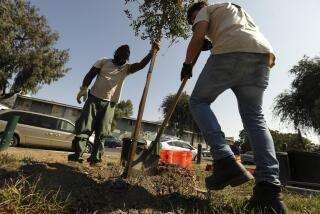Canyon Country Oak Still Standing as Developer Rethinks Store Plans
An old oak, which stands where a convenience store is scheduled to be built in the Santa Clarita Valley, has been spared the developer’s ax for at least a month.
John Huttinger, a hearing officer with the Los Angeles County Regional Planning Commission, told the developer Tuesday to redraw the project’s blueprints to save the oak or document why saving the tree would be impossible.
The decision was applauded by the oak’s admirers, who flooded the planning commission with 450 letters, condemning plans to cut the huge tree and eight smaller oaks in Canyon Country. During a rally for the coastal live oak on Saturday, residents tied yellow ribbons around it and talked about the heritage of the Valley’s dwindling number of oaks, many of which were saplings when Indians roamed the hills.
“The developers are barking up the wrong tree. If you can’t save the oak tree, don’t build,” said Candi Roth, one of several area residents who testified at the hearing. “Who needs another convenience store which sells bad foodstuffs and 3-year-old peanut butter?”
$2.5-Million Center
The developer, Joseph Kashani, promised to examine the possibility of changing the blueprints for the $2.5-million shopping center. But Kashani’s attorney, Leon Pizante, said his client might sue the county if the plans are killed or must be radically changed.
Searching for a compromise, Huttinger asked the developer and the tree enthusiasts whether the oak could be drastically trimmed or relocated. Both sides were unhappy with those suggestions.
Costly to Move
Moving it would cost $60,000 to $200,000 and take up to a year, the developer’s representatives said, and radically trimming the tree, crowned by boughs spanning 86 feet, would create an eyesore.
Either alternative could kill the tree, warned Clyde Sims, a deputy county forester.
“Those large limbs coming off that tree would obviously make a great difference in the look of the tree,” Sims said. “In my opinion, it would not be an aesthetically pleasing tree. There is a question it would even survive.”
‘No-No’ for Developer
The project’s architect, Denny Lord, argued that preserving the tree would obscure 15% of the shopping center’s space from passers-by. “In shopping-center design, owners are very much concerned about the visibility of each store,” Lord said. Given that concern, leaving the tree would be “a no-no for the developer,” he said.
But Dorothy Riley, a Valley resident active in attempting to preserve the area’s oaks, criticized the developer for not trying hard enough, calling for “real creativity in design.”
Although the tree’s admirers marveled at the beauty of the oak, which the county estimates to be 150 to 300 years old, their opponents called its drooping branches a hazard.
“When a tree hangs down to the ground, it poses safety problems to people passing by,” Pizante contended. “I don’t think this oak is representative of oaks in the area because of the way it has grown.”
The tree debate was triggered by the county requirement that a developer obtain a permit before altering or removing an oak with a diameter of eight inches or more. The county may approve the removal of a tree if the developer shows that redesigning a project to save the oak is financially unfeasible.
After Huttinger decides, his opinion may be appealed to the regional planning commission and, eventually, to the county Board of Supervisors.
More to Read
Sign up for Essential California
The most important California stories and recommendations in your inbox every morning.
You may occasionally receive promotional content from the Los Angeles Times.










